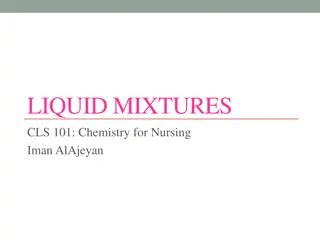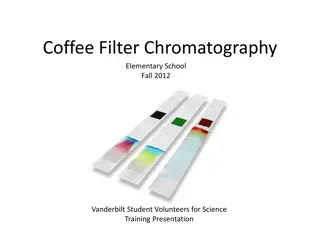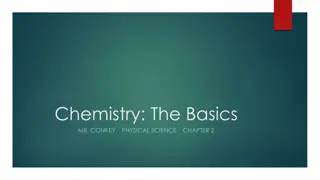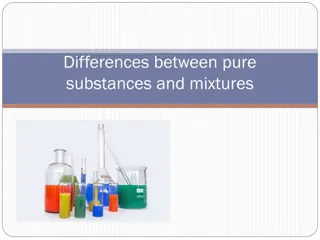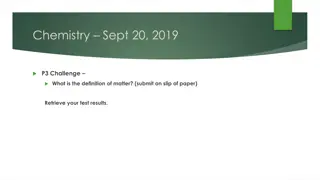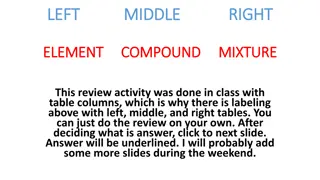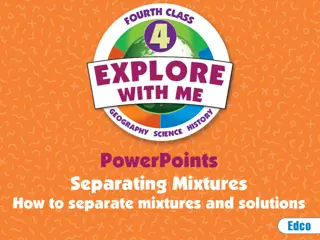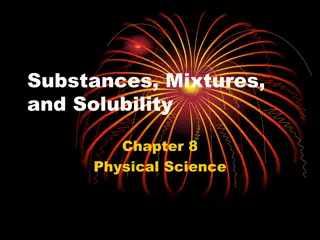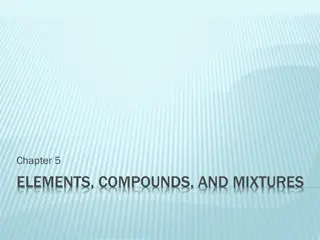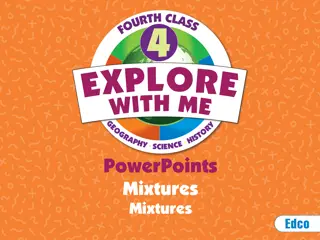Understanding Mixtures and Separation Techniques
Explore the concepts of mixtures and separation, from the definition of dominant and recessive alleles to the advantages of electron microscopes. Learn about identifying pure substances, differences between pure and impure substances, and techniques like filtration and crystallization for separation. Discover why mixtures may not have a single melting temperature and the distinctions between pure substances like bronze and impure substances like G and I.
Download Presentation

Please find below an Image/Link to download the presentation.
The content on the website is provided AS IS for your information and personal use only. It may not be sold, licensed, or shared on other websites without obtaining consent from the author. Download presentation by click this link. If you encounter any issues during the download, it is possible that the publisher has removed the file from their server.
E N D
Presentation Transcript
Mixtures and Separation L/O explain how to separate different mixtures Last week:Define the terms: Dominant allele Recessive allele Last term: Describe the advantages of an electron microscope Last Year: An object was magnified 250 times to produce an image that was 40mm across. Calculate the actual size of the object. Actual size = Key Words Mixtures Chromatography Crystallisation Filtration Distillation Image size magnification
A pure substance has only one type of molecule in it. Identify which of these diagrams show a pure substance
A pure substance has only one type of molecule in it. The circled diagrams all show a pure substance because they only have one type of molecule.
A pure substance consists only of one element or one compound A mixture consists of two or more different substances, not chemically joined together
A pure substance has a fixed melting and boiling point. An impure substance melts and boils at a range of different temperatures
Bronze: Describe the difference between a pure substance and an impure substance. Silver: Justify why G is a mixture (impure substance) but I is a pure suibstance Gold: Explain why a mixture of different substances might not have a single melting temperature.
Filtration Filtration allows you to separate an insoluble solid from a liquid The liquid is able to pass through the filter paper but the solid cannot.
Crystallisation If you have a soluble solid dissolved in a liquid, you cannot separate them by filtration. You can evaporate the liquid, leaving behind the solid. This works because the solid has a much higher boiling point than the liquid
Filtration and crystallisation can be used together if you have both a soluble solid and insoluble solid. For example a mixture of sand, salt and water. https://www.youtube.com/watch?v=vi_SJBnxmHo
Bronze: Produce a clear, labelled diagram showing how filtration and crystallisation can be carried out. Silver: Justifywhy filtration and separation can t always be used for the same mixtures. Gold: Evaluate the methods for both filtration and crystallisation. Identify any possible mistakes that could be made and hazards when carrying them out.
Chromatography Paper chromatography is used to separate mixtures of soluble substances. These are often coloured substances such as food colourings, inks, dyes or plant pigments.
Chromatography Some inks dissolve more easily than others. This means they will move up the paper faster.
Chromatography In chromatography there are 2 phases: Stationary phase the paper (it doesn t move) Mobile phase the solvent / liquid (it does move)
Chromatography Separation by chromatography produces a chromatogram. A paper chromatogram can be used to distinguish between pure and impure substances: a pure substance produces one spot on the chromatogram an impure substance, or mixture, produces two or more spots Distance the ink moved from the pencil line Distance the solvent liquid moved from the pencil line Rf =
Chromatography For each spot you can calculate the Rf value. The Rf value tells you how easy it was for that substance to dissolve and move up the paper.





